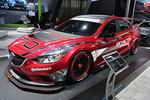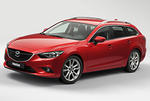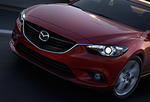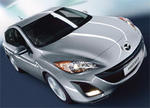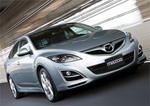
The 2008 Mazda6 has its Australian debut today at the Australian International Motor Show in Sydney.
The Australian 2008 Mazda6 is powered by a 2.5 liter engine that develops 125 kW and 226 Nm of torque. The Australian 2008 Mazda6 is equipped with Dynamic Stability Control (DSC) and Traction Control (TCS), ABS anti-lock brakes and six airbags.
Mazda Press Release:
All-New Mazda6 A Head Turner in Oz
The all-new Mazda6, unveiled today at the Sydney Motor Show, will deliver class leading looks and
refinement, more power, better fuel economy and outstanding value when it goes on sale about April next year.
“The Mazda6 launched in 2002 was the first of Mazda’s Stylish, Insightful and Spirited models and it has proven to be great success averaging over 1000 sales a month when our target for this car was 600. We now have 64,022 Mazda6 owners across Australia,” said Doug Dickson, managing director of Mazda Australia. “The all new car therefore has big shoes to fill but it’s very much up to the job.
“The new model Mazda6 will raise the medium car standard across the board, offering more performance, improved economy, more refinement, sharper dynamics, lots more features and it will again be available in sedan, hatch and wagon body styles.”
With prices expected to start about $30,000 the Australian-bound all-new Mazda6 sedan, hatch and wagon will offer a new 2.5-litre engine boasting 125 Kilowatts of power and 226 Newton metres of torque. That’s almost ten percent more torque than the current car.
The second generation Mazda6 will also be safer than before and for the first time Dynamic Stability Control (DSC) and Traction Control (TCS) will be available across the range.
While final specifications have yet to be confirmed, the all-new Mazda6 will be generously equipped with air-conditioning, remote keyless entry, power mirrors and windows, remote central locking, six airbags, ABS anti-lock brakes and MP3 player connectivity.
The all-new Mazda6 builds on the design success of the current car by offering an evolved exterior shape that combines traditional Japanese aesthetics with a timeless “Bold and Exquisite” design theme.
Chief Designer Youichi Sato set himself the challenge of creating a timeless yet modern design that would “…embody a Japanese design identity.”
The final design is an evolved Zoom-Zoom form with a unique exterior character. This is expressed by the interplay of discreetly flowing curves and prominent edges from the front end through the fenders, and through the taut curves that lend richness and strength to the rear view.
The door panel placed between the sharp top and bottom character lines convey an expression of beauty from simplicity.
While inheriting the ‘athletic’ design key to the signature Mazda look of the previous model and redefined in the new Mazda2, the new Mazda6 is yet a stronger statement of driving dynamism.
Sato-san’s design theme is embodied in the new Mazda6’s sporty styling that is sure to turn heads. “Japanese aesthetics give new Mazda6 its unique visual identity”, says Sato. “Rather than being derived from traditional sculpted forms, it stands apart from its rivals by straightforwardly expressing the Japanese aesthetic sense to embody a new and advanced character.”
Not just good looks, the all-new Mazda6 also promises to deliver a driving performance “that creates oneness between the car and driver". This has been achieved by driving dynamics, steering, handling, and brake performance that respond accurately to the driver’s intentions.
Also, the further enhanced high-quality ride and quietness help create this feeling of “oneness” between the car and the driver. While reducing the overall noise of the engine, engineers also emphasised certain frequencies to overlay a sporty engine note on the serene backdrop.
The 2.5-litre engine uses a dual-mass damper and a flexible flywheel and also focused on weight reduction of pistons and connecting rods. With this, it was possible to reduce combustion noise as well, achieving some of the lowest vibration level measurements in the class.
To reduce road noise while promoting handling stability, engineers reinforced body structures to suppress vibration transmitted from the road to the car body as well as noise radiated from panels. This results in some of the lowest road noise measurements in the class on all road surfaces whether smooth or rough.
The sporty and sophisticated interior design perfectly expresses the all-new Mazda6’s “Bold and Exquisite” design theme. For the sporty aspect, the designers created a snug, cockpit-like driving environment with a relaxed driving position, clear instruments and intuitive controls to support it.
The design of the dashboard and door trim builds an exquisite contrast of grace and sharp, mechanical dignity to yield a space where the driver and passengers travel in pleasure, comfort and calmness, helped by the way the facia top curves away from the occupants and seems to float above the structure beneath.
Overall the all-new Mazda6 will also deliver a larger, up-market cabin with sporty proportions. By lengthening the new car’s wheelbase by 55mm, slightly widening its body (by about 15mm) and keeping the same spacing between the driver and passenger seats as before, results in more shoulder room for front and rear passengers. Knee room for rear passengers is increased by 13mm for a spacious rear seat.
The new model also offers a more refined driving position for confident, comfortable control. Besides having a more upright steering wheel, the gear lever is moved slightly towards the driver compared with the previous model. The driver’s seat armrest has an adjustable front-back slider mechanism, which allows drivers to rest their elbow comfortably while changing gears.
Whether driving in the city or on the open road, the suspension system delivers a responsive and reassuring drive. The high-mounted double-wishbone front suspension is mounted on a subframe now attached to the body at six points instead of four, for a further refined steering stability.
In the multi-link rear suspension, the front pivot of the trailing link is now placed higher to reduce tail-lift under braking, and the dampers are mounted more upright to improve the leverage acting on them and thus their responsiveness. These modifications enhance both handling stability and ride comfort.
As well as achieving high body rigidity, Mazda engineers worked on reducing weight to further improve dynamic performance and fuel economy. Reinforcement at key points and the widespread use of high-tensile and ultra-high-tensile steel brought significant increases in torsional stiffness, up by 30 percent for the hatchback, 25 percent for the wagon and 14 percent for the sedan. Despite this, the body shell's weight is greatly reduced to class leading levels due to the increased percentage by weight of high-tensile and ultra-high-tensile steel sheet and optimal layout created by using CAE technology.
Attractive styling and aerodynamic efficiency go hand-in-hand with the Mazda6. From the early stages of development, Mazda engineers utilized simulation testing to the fullest in order to improve their initial designs, and then carefully fine-tuned them with prototypes and the wind tunnel. In the end, they achieved a remarkable drag coefficient (Cd) of 0.27 for the hatchback and sedan versions and 0.28 for the estate. New horseshoe-shaped air deflectors ahead of the front wheels ensure adequate brake cooling despite the low Cd. Fore-and-aft lift balance is also optimised, keeping the car stable and firmly grounded at high speed.

